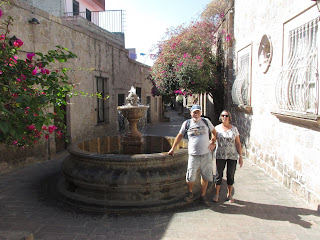The aquaduct is also one of the historical venues.
This
beautiful aqueduct of quarry pink, measure 1810 meters and consists
of 253 arches and two boxes of water.
Construction take us to the days of the golden age of the former Valladolid. In 1785 Bishop Fray Antonio de San Miguel commanded to built an aqueduct with two purposes: to bring drinking water to the city which was hit by a terrible drought for two years and to provide work for the indigenous people of the region. The stone was transported from the village of Santa María (now part of the city) and goes to the old Calle Real. Today, Madero avenue.
Construction take us to the days of the golden age of the former Valladolid. In 1785 Bishop Fray Antonio de San Miguel commanded to built an aqueduct with two purposes: to bring drinking water to the city which was hit by a terrible drought for two years and to provide work for the indigenous people of the region. The stone was transported from the village of Santa María (now part of the city) and goes to the old Calle Real. Today, Madero avenue.
Here are a few photos of our tours:
The Historic Centre of Morelia is located in central Mexico, at the foot of the Sierra Madre Occidental and near the agricultural valley of Morelia-Querendaro. Built in the 16th century according to a "checkerboard" layout, Morelia is an outstanding example of urban development combining town planning theories of Spain and the Mesoamerican experience. Well suited to the slopes of the central hill of the valley, its streets follow the original layout. The city has major axes, numerous urban squares, of which the vast rectangular Zocalo Plaza, and gardens that create an open, airy ensemble with magnificent vistas of the surrounding hills.
The central part of the Historic Centre of Morelia includes 249 monuments of prime importance, of which 21 churches and 20 civil constructions, which crystallize the architectural history of the city. The sobriety of the urban townscape is enhanced by many Baroque facades characteristic of the religious foundations, including the cathedral and the churches of Santa Rosa, de las Monjas and Guadelupe. Although the majority of the monuments were erected in the 17th and 18th centuries, styles of earlier and later periods (Middle Ages, Renaissance and Neoclassicism) merge in the creation of the "Baroque Moreliano". Together, they form a harmonious unity that reinforces the measured use of architectural elements in pink stone, the numerous arcades and imposing towers and cupolas covered with azulejos that dominate the city.
Founded in the 16th century under the name of Valladolid, the city was, at the beginning of the 19th century, one of the main centres of the struggle for independence of the country. Two priests received notoriety: Miguel Hidalgo and José María Morelos. It is to the glory of the latter, a native of Valladolid, that the city was renamed Morelia in 1828.
The original model of urban development, which is one of the universal values of the Historic Centre of Morelia has been maintained. In addition, the urban public space has preserved its integrity and the streets still follow the original layout.
Despite the changes of use required to meet the needs of civil society, the monumental Baroque style buildings have preserved their own architectural characteristics. The transformation of old residential buildings to new uses related to tourism has been achieved in respect of the integrity of the inscribed site.
It should be noted, however, that built heritage in good condition is found mainly in the heart of the historic centre. Conservation of the built heritage of traditional and neighbouring quarters has received less attention and the number of buildings in poor condition has increased.
Restoration work on the monumental ensembles, especially religious, was carried out in accordance with the criteria of authenticity of the site. The recuperation of urban areas for community purposes has enabled an appreciation of all their wealth, while promoting their conservation. Dissemination campaigns on the important historical events of Morelia help to strengthen the memory of the Historic Centre. In this regard, various events have been staged to commemorate the Bicentennial of Mexican Independence.
With regard to conservation practice that affected the authenticity of some buildings (the removal of exterior plaster), considered in the evaluation report of ICOMOS in 1990 as inconsistent with the Charter of Venice, a slow recovery process of the facades of significant monuments was initiated following the inscription on the World Heritage List in 1991.
Concerning the aesthetic falsifying of contemporary buildings (application of a colonial facade on a new building), this local construction practice has been restricted since 1993. The Urban Development Programme for the Historic Centre of Morelia, approved in 2001 by the Municipal Cabildo, henceforth prohibits construction of contemporary buildings that mimic historical styles.
The next day we took a tour to visit Patzcuaro, Quiroga, Tzinzuntzan, and La Isla Janizio.








No comments:
Post a Comment